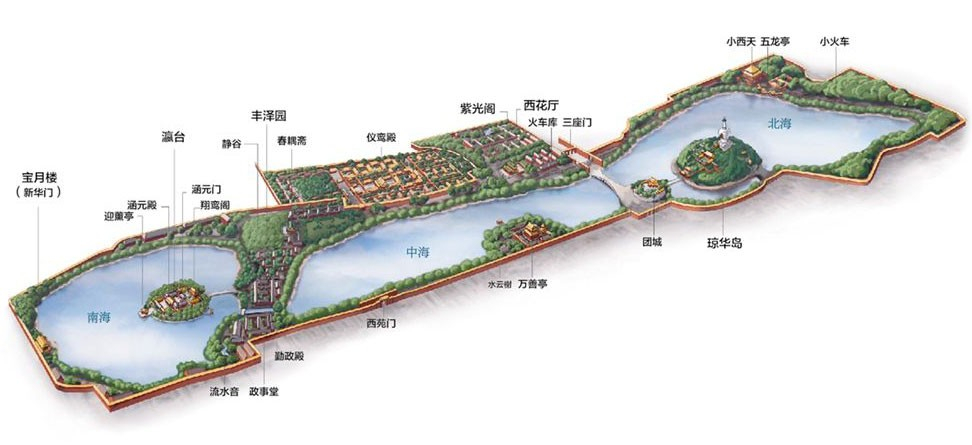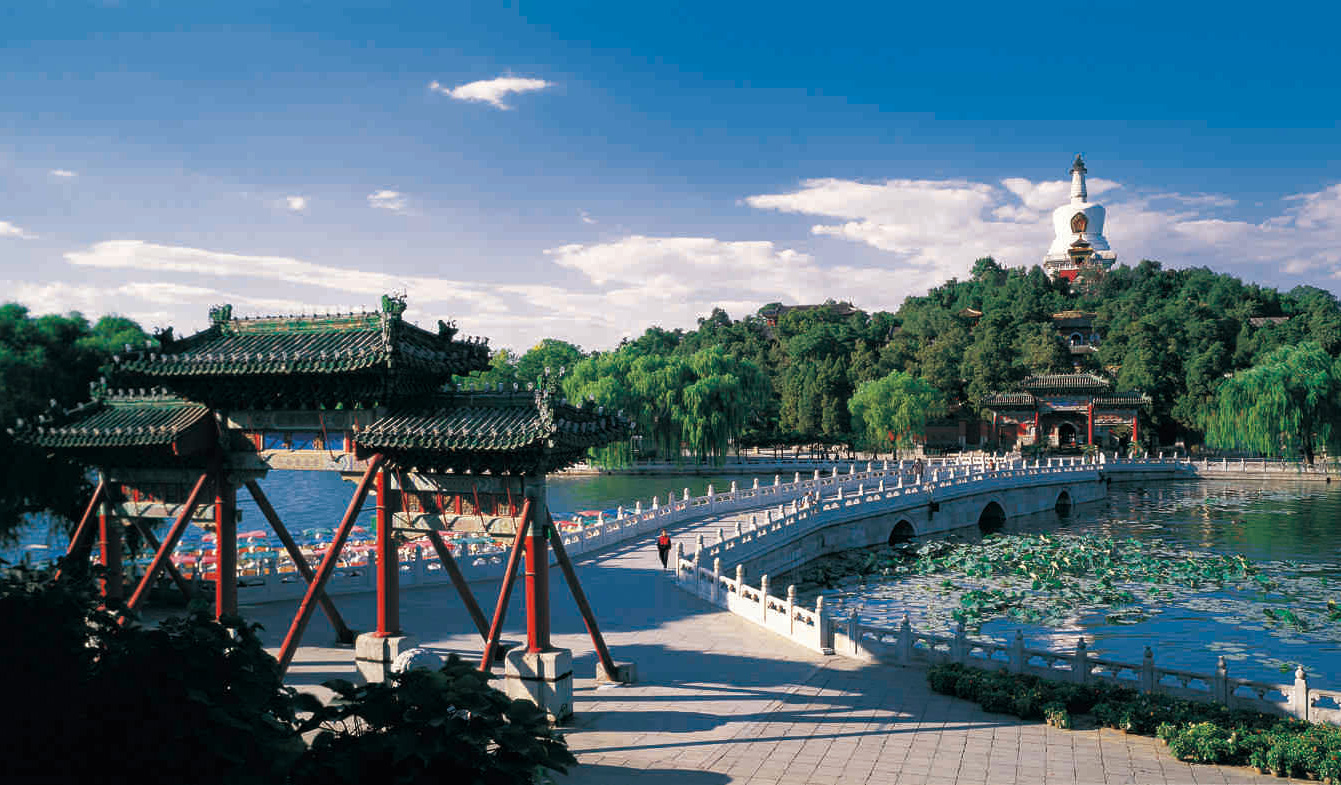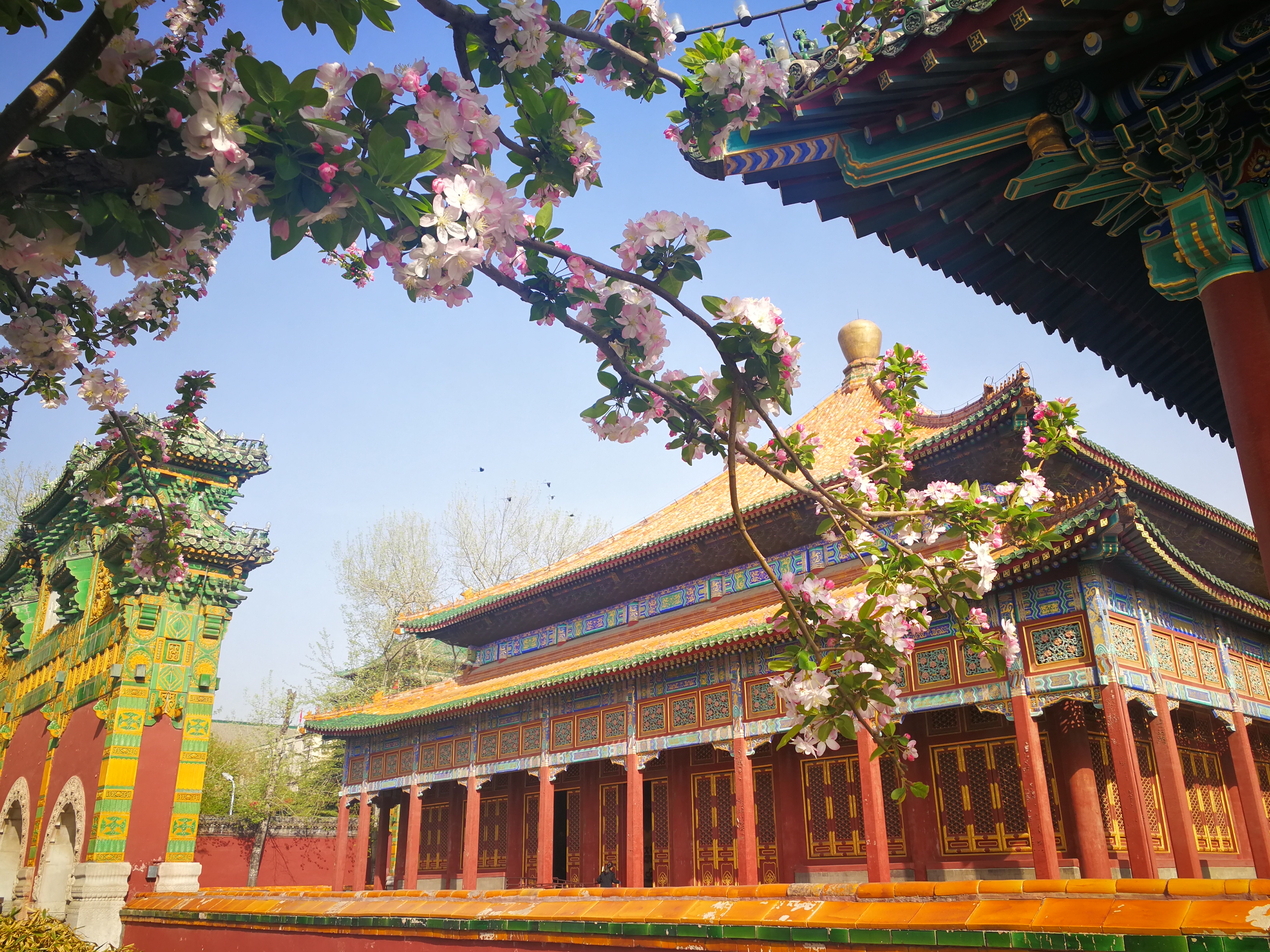

北海公园位于中华人民共和国北京市城区的中偏北部,故宫和景山的西北侧,始建于宋辽金时代,是世界上现存建园时间最早的皇家宫苑。北海的布局以琼华岛为主体,在岛的顶端建有标志性建筑永安寺白塔,与南岸的团城、北岸的宫苑群遥相呼应,相互借景,构成园林的南北中轴线。
北海先后历经辽、金、元、明、清五朝的兴建,历史悠久且重建时承袭较多。它始建于辽代,当时位于辽南京城的东北郊外,附近风景秀丽,于是统治者便疏浚水系,仿照蓬莱仙境建造了瑶屿行宫。金大定十九年(1179年)起,在瑶屿行宫的基础上叠石造山,修建了广寒殿,同时将湖泊称为“西华潭”,瑶屿改名为“琼华岛”,将整座离宫命名为“大宁宫”(后来又改称“万宁宫”)。
元代以琼华岛为中心规划了大都城,忽必烈在中统三年(1262年)、至元四年(1267年)和至正八年(1348年)三次扩建琼华岛,构成了“一池三山”的蓬莱仙境格局. 在旧殿基础上兴建了重檐圆顶的仪天殿,岛的四周也围起了石墙,叫圆城,就是如今的团城。将山命名为“万寿山”(或“万岁山”),北海命名为“太液池”。这样,琼岛是“蓬莱”,团城就是“瀛洲”,所以仪天殿也叫“瀛洲圆殿”。同时,还在太液池的东岸修建了大内皇宫,在西岸建造了隆福宫和兴圣宫,构成一座巨大的宫苑——“上苑”。
明成祖朱棣永乐十八年(1420年),明王朝定都北京后,在太液池以东建造了皇宫紫禁城,并向南拓展水系,形成中海、南海,与北海一起合称“西苑”,划入皇城的范围。万历七年(1579年),广寒殿倒塌,此后一直没有修复,直到清代顺治八年(1651年),才应喇嘛所请,在广寒殿旧址上兴建了白塔,并将岛南部的宫殿改建为永安寺。清代乾隆六年(1741年)起,北海开始了长达三十年的扩建,除了在琼华岛的四面广建庭轩楼榭外,还在太液池的北岸和东岸增加了许多建筑群,形成今日的格局。
Der Nordmeer Park ist auch ein prähistorisches Park in Peking, das im Jahr 1179 schon angefangen zu bauen. Er ist ein kaiserlicher Park und hat einen großen See, um den wird es „grün“ gedeckelt. Im Sommer ist dort ein schöner Ort zum Sommerfrischen. Im Frühling wäre es noch besser, weil, es gibt drei Inselchen im See, Einer davon heißt „Qionghua“, das ist auch Eine von „Yanjing 8 Landschaften von Peking - Jade Inselchen im schattigen Frühling. Ein aus weißen Marmor bestehend Turm ist sehr berühmt und auffallend. Im Park kannst Du nur was Frisches und Schönes fühlen.
Der Beihai-Park (chinesisch 北海公園 / 北海公园, Pinyin Běihăi Gōngyuán) in Peking ist einer der typisch chinesischen Gärten. Er liegt nordwestlich der Verbotenen Stadt.
Von der Dschurdschischen Jin-Dynastie bis zur Zeit der Ming- und Qing-Kaiser war der Nordsee (Beihai) gemeinsam mit dem Mittelsee (Zhonghai) und später auch dem Südsee (Nanhai) Teil der verbotenen Stadt. Während das Gelände um die beiden letztgenannten Seen heute unter dem Namen Zhongnanhai als Sitz von Regierung und Partei dient und daher hermetisch abgeriegelt ist, steht der Beihai einschließlich des sich an seinen Ufern erstreckenden Parks seit 1925 der Öffentlichkeit zur Verfügung.
Der Jin-Kaiser Shizong begann 1179 n. Chr. mit der Errichtung eines Sommerpalastes und der Anlage dieses Parks. Kaiser Kublai Khan machte ihn 1260 zu seiner Residenz, indem er die „Halle der Weiten Kühlung“ bezog. An ihrer Stelle wurde durch die Qing-Kaiser ab 1651 die lamaistische „Weiße Pagode“ erbaut, die noch heute den Park dominiert. Kaiser Qianlong (1736–1795) führte umfangreiche Erweiterungsarbeiten durch. Nahezu alle heutigen Bauten in diesem Park stammen aus dieser Bauperiode.
北海公園(ほっかいこうえん、簡体字中国語: 北海公园、拼音: )は中華人民共和国北京市にあり、故宮の北西に位置する宮廷庭園(旧皇帝御園)である[1][2]。華北を征服した元朝のクビライは、この島を中心に大都を設計した。 遼代に作られた離宮を起源とし、金、モンゴル、明、清と継承された[1]。モンゴル時代には政治的貢献の大きかった長春道人・丘処機に与えられ、北海の中央にある瓊華島に道観(道教の寺院)が作られた[1]。のちに帝位についたクビライが 瓊華島に住んだこともある[1]。公園として一般開放されたのは、中華人民共和国建国後のことである[2]。
Beihai Park (Chinese: 北海公園; 北海公园)is a public park and former imperial garden located in the northwestern part of the Imperial City, Beijing. First built in the 11th century, it is among the largest of all Chinese gardens and contains numerous historically important structures, palaces, and temples. Since 1925, the place has been open to the public as a park. It is also connected at its northern end to the Shichahai.
The park has an area of more than 69 hectares (171 acres), with a lake that covers more than half of the entire park. At the center of the park is an island called Jade Flower Island (瓊華島; 琼华岛; Qiónghuádǎo), whose highest point is 32 meters (105 ft).
Beihai literally means "Northern Sea". There are also corresponding Central (Zhonghai) and Southern (Nanhai) "Seas" elsewhere. These latter two are joined inside a complex of buildings known after them as Zhongnanhai; it is the home of China's paramount leaders.
The Beihai Park, as with many of Chinese imperial gardens, was built to imitate renowned scenic spots and architecture from various regions of China such as Lake Tai, the elaborate pavilions and canals of Hangzhou and Yangzhou, the delicate garden structures in Suzhou and others all served as inspirations for the design of the numerous sites in this imperial garden. The structures and scenes in the Beihai Park are described as masterpieces of gardening technique that reflects the style and the superb architectural skill and richness of traditional Chinese garden art.[1]
Le Parc Beihai (chinois simplifié : 北海公园 ; chinois traditionnel : 北海公園 ; pinyin : ) est un jardin impérial de Pékin, vieux de plus de 1 000 ans. Le nom de Beihai (chinois : 北海 ; pinyin : Běihăi, littéralement la « mer du nord ») évoque le lac qui forme l'essentiel de sa superficie et se trouve justement au nord du Zhongnanhai (littéralement les « mers du sud et du centre »).
La construction du parc a commencé au Xe siècle, sous la dynastie Liao. Avec une superficie supérieure à 68 ha, il s'agit d'un des plus grands jardins chinois, aménagé autour du lac, contenant de nombreux bâtiments historiques, parmi lesquels des temples et des palais, comme cette stūpa blanche, emblème du parc, bâti sur une île au milieu du lac.
Comme beaucoup de jardins impériaux chinois, il a été construit dans un esprit d'imitation des paysages et architectures les plus remarquables de Chine. Auparavant clos, le parc est aujourd'hui ouvert au public et facilement accessible via les transports en commun.
Il parco Beihai (cinese tradizionale 北海公园, pinyin Běihǎi Gōngyuán) è un giardino imperiale a nord-ovest della Città proibita di Pechino. Costruito in origine nel X secolo, è un tipico giardino cinese, aperto al pubblico solo dal 1925 e parte della Città proibita fino alla fine della dinastia Qing nel 1911.
Il parco si estende su più di 700.000 m², con il Lago Settentrionale o Beihai che ne copre più di metà. Al centro si trova un'isola chiamata Qióng-huá (琼华) alta fino a 32 metri sul livello del lago. Il grande specchio d'acqua detto Taiye si collega al Lago Posteriore o Houhai e al Lago Medio o Zhonghai, intorno a cui si trova lo Zhongnanhai. Beihai significa letteralmente Lago Settentrionale.
El Parque Beihai (en chino tradicional, 北海公園; en chino simplificado, 北海公园; pinyin, Běihǎi Gōngyuán) es un jardín imperial situado al noroeste de la Ciudad Prohibida en Pekín, China. Construido en el siglo X, es uno de los mayores jardines chinos, y contiene muchas estructuras, palacios y templos de importancia histórica. Desde 1925, ha estado abierto al público como un parque. Está conectado por el norte con el Shichahai.
El parque tiene una superficie de más de 69 hectáreas. Contiene un lago que cubre más de la mitad de todo el parque. En el centro hay una isla llamada Isla Qiónghuá (琼华) cuyo punto más alto tiene 32 m de altura. En el norte del parque hay un gran estanque llamado Estanque Taiye, que conecta los otros dos estanques, Mar Central y Mar del Sur (Zhongnanhai). El Estanque Taiye también se llama Beihai, que significa "Mar del Norte". El complejo de edificios alrededor de Zhongnanhai albergan la residencia de los líderes supremos de China.
El Parque Beihai, como muchos jardines imperiales chinos, se construyó para imitar lugares turísticos famosos y la arquitectura de diferentes regiones de China. En el Lago Taihu, los elaborados pabellones y canales de Hangzhou y Yangzhou, las delicadas estructuras de los jardines de Suzhou sirvieron como inspiración para el diseño de numerosos lugares en este jardín. Las estructuras y escenas del Parque Beihai se describen como obras maestras que reflejan el estilo y la excepcional arquitectura y riqueza de los jardines tradicionales chinos.1
Парк Бэйхай (кит. трад. 北海公園, упр. 北海公园, пиньинь Běihăi Gōngyuán) — императорский сад к северо-западу от Запретного города в Пекине. Первоначально заложен в X веке. Числится среди крупнейших китайских садов и содержит множество исторически значимых построек, дворцы и храмы. Во времена правления династий Ляо, Цзинь, Юань, Мин и до падения династии Цин в 1911 году был императорским парком. Это место было связано с Запретным Городом, но с 1925 года сад был открыт публике.
Парк имеет площадь более 69 гектаров; озеро Бэйхай занимает более половины территории парка. В центре парка на 32 м возвышается остров Цюнхуа (琼华). К северу от парка находится озеро Цяньхай, к югу — Чжунхай (Среднее море).
Бэйхай дословно значит «Северное море». Также имеются Среднее (Чжунхай) и Южное (Наньхай) моря. Комплекс строений вокруг двух вышеупомянутых озёр включает дома, в которых живёт китайское высшее руководство.
Парк Бэйхай, как и многие китайские сады, был построен для подражания знаменитым живописным местам и архитектурным объектам разных частей Китая; озеро Тайху, искусно сделанные павильоны и каналы в Ханчжоу и Янчжоу, изысканные постройки китайского сада в Сучжоу и другие служили вдохновением для творцов многочисленных достопримечательностей этого императорского сада. Постройки и пейзажи этого парка являются шедеврами ландшафтного дизайна, отображающими стиль и великолепные архитектурные навыки и богатство искусства создания традиционного китайского сада.












